11 Best Free Online Camera Field of View Calculator Websites
Here is a list of the best free online camera field of view calculator websites. The field of view (FOV) of a camera is the observable scene that the camera can capture. It represents the area that falls within the camera’s imaging sensor. FOV is measured in degrees. It defines the angular coverage of the captured image.
The field of view of a camera depends on two main factors; focal length and sensor size. Basically, you need to know the sensor size, focal length, and distance to calculate a camera’s field of view. There are additional factors that can influence FOV such as lens distortion.
This post covers 11 websites with different field of view calculators. Some of these calculators are simple and straightforward. Whereas some calculators can help you perform comprehensive calculations for Field of View, Angle of View, Depth of Field, and more. With that said, let’s dive into the list and explore these calculators in detail.
My Favorite Online Camera Field of View Calculator
The calculator offered by PointsInFocus.com is my favorite camera field of view calculator on this list. This is a sophisticated yet simple-to-use calculator that gives you various insights along with the field of view. It calculates the camera field of view in multiple orientations. With additional configurations, it calculates other experimental values and plots a depth of field graph at different aperture values of the selected sensor size.
You can check out our other lists of the best free Online Depth of Field Calculator Websites, Lighting Simulation Software for Windows, and Optics Simulation Software For Windows.
Comparison Table:
| Name | FOV | FOV Orientation | Additional Info |
|---|---|---|---|
| PointsInFocus.com | ✓ | Vertical, Horizontal, Diagonal | Depth of Field, Angle of View, etc. |
| OmniCalculator.com | ✓ | Vertical, Horizontal, Diagonal | Angle of View |
| ScanTips.com | ✓ | Vertical, Horizontal, Diagonal | Angle of View, Focus Dist. etc. |
| Astronomy.tools | ✓ | - | Angle, Focal Ratio, etc. |
| Commonlands.com | ✓ | Vertical, Horizontal, Diagonal | Angular Resolution |
| UltimateSecurity.com | ✓ | Vertical, Horizontal | - |
| 1stVision.com | ✓ | Vertical, Horizontal | - |
| Pelco.com | ✓ | Vertical, Horizontal | - |
| ChannelSystems.ca | ✓ | Vertical, Horizontal | - |
| Fluke.com | ✓ | Vertical, Horizontal | Spot |
| Workswell-Thermal-Camera.com | ✓ | Vertical, Horizontal, Diagonal | IFOV, Spot |
PointsInFocus.com
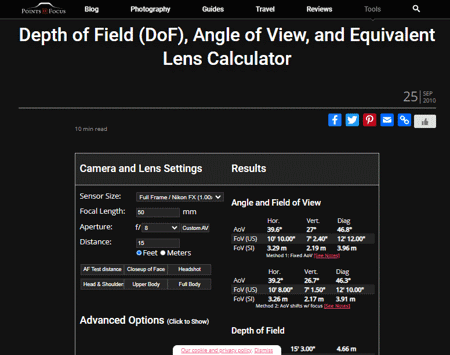
PointsInFocus.com is a free online calculator that you can use to determine the field of view, depth of view, angle of view, etc. You can do this all in a single calculator that comes with a catalog of popular sensor sizes. You can pick a relevant sensor size or go with custom configurations to set a custom sensor size. Then you have to provide some additional parameters covering focal length, aperture, and distance. With that, the calculator gives you the field of view, depth of field, and angle of view. It shows all these three parameters for vertical, horizontal, and diagonal orientations.
This calculator has advanced options where you can configure the Circle of Confusion Method, Custom Circ. of Configuration, Sensor Resolution, and Shutter Speed. Based on these parameters, it calculates additional Experimental Values. The web page also plots a depth of field graph for different focal positions. Along with that, it lists other equivalent lenses that you can use as an alternative to get similar results.
How to calculate the camera field of view?
- Follow the link given below to open this calculator.
- Select your sensor size from the dropdown.
- Enter the focal length, aperture, and distance.
- This gets you the field of view of the configured camera sensor and settings.
Highlights:
- This calculator calculates the field of view for vertical, horizontal, and diagonal orientations.
- It comes with a catalog of popular sensor sizes along with the option to configure a custom sensor size.
- It calculates angle of view and depth of field as well.
- The webpage shows a depth of field graph for different focal values of the selected lens.
- It lists a catalog of equivalent camera lenses as per the calculations.
OmniCalculator.com
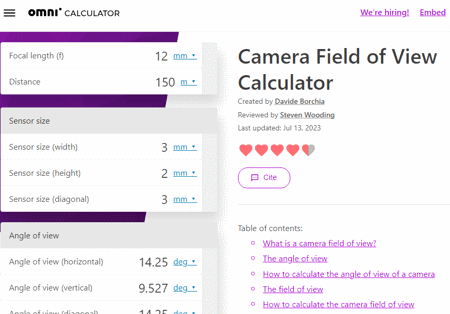
OmniCalculator.com has an online Camera Field of View Calculator that can help you estimate the approximate field of view of a particular camera sensor. The uniqueness of OmniCalculator is that it provides definitions, explanations, and other theoretical information about a calculator in detail. The same is true for this camera field of view calculator. You can read about it along with other related terms and formulas.
Coming to the calculator, it sits on the left side of the web page covering four sections. The first two sections are for input. The first section takes the Distance and Focal length inputs. And the second section asks for sensor size where you can enter the width, height, and diagonal measurements of the sensor. Based on that, the calculator gives you the angle of view and field of view for the added orientations.
How to calculate the camera field of view?
- Enter the focal length and distance in the selected unit of your choice.
- Then provide the width/height/diagonal camera size to the calculator.
- This gets you the horizontal/vertical/diagonal field of view of the camera size.
Highlights:
- This calculator calculates the field of view for vertical, horizontal, and/or diagonal orientations.
- It also calculates the angle of view in multiple orientations.
ScanTips.com
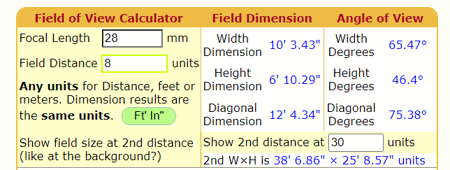
ScanTips.com offers a comprehensive online Field of View Calculator for a camera and lens. It starts with a guide to help you understand how to use this calculator. The calculator features presets of Film and Sensor Size Descriptions that you can easily pick and run the calculations with focal length and distance. The calculator gives you the field dimensions covering width, height, and diagonal. Alongside that, it also shows the angle of view for width, height, and diagonal.
If you don’t want to use a preset, you can configure your exact camera and lens settings in the calculator. You can start with the native camera sensor size and then add sensor crop factor, Focal length of the lens, Equivalent focal length on 35 mm film or 1x sensor, Aspect Ratio, Film and Sensor Size Description, etc. The calculator can also help you calculate the Focal Length for a Field of View Angle, Find Distance for Magnification, Sensor Size, etc.
How to calculate the camera field of view?
- Set the focal length and field distance at the top of the calculator.
- This gets you the field dimensions and angle of view for the default camera sensor size.
- Then change the native sensor size along with crop factor, lens parameters, and other additional settings.
- After that, click the ReCompute button to get the output as per your camera sensor and lens configuration.
Highlights:
- This comprehensive calculator lets you configure the camera sensor and lens.
- The calculator features camera presets that you can easily pick and re-configure.
- It factors in many factors such as sensor crop, the focal length of the lens, etc.
- It calculates the field of view dimensions covering width, height, and diagonal.
Astronomy.tools
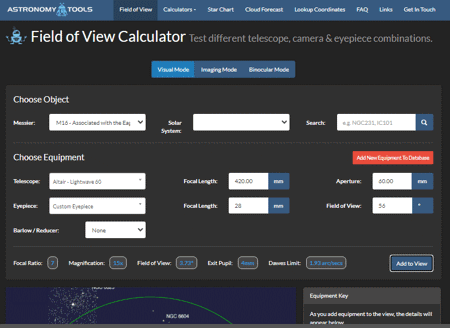
Astronomy.tools is a collection of anatomy tools covering calculators, star charts, cloud coverage forecasts, and more. The website has a Field of View Calculator that allows users to test different telescope, camera, and eyepiece combinations. The calculator has three modes: Visual Mode, Imaging Mode, and Binocular Mode. You can choose an object, and add equipment to the view. You can pick the object you are planning to view or search the data to find objects. Then you can set the instruments that cover the telescope and the camera. You can either pick one from the given list or add configure for custom calculations. When you do that the details will appear below. It gives you the field of view, magnification, focal ratio, exit pupil, and Dawes limit.
How to calculate the camera field of view?
- Open this calculator and select the Imaging Mode from the top.
- Choose an object that you are planning to view.
- Then choose equipment covering the telescope and the camera and press enter.
- This gets you the Field of View along with other parameters.
Highlights:
- This calculator is to test different telescope, camera, and eyepiece combinations.
- It calculates the field of view, magnification, focal ratio, exit pupil, and Dawes limit.
- This calculator is for space explorations and not for regular photography.
Commonlands.com
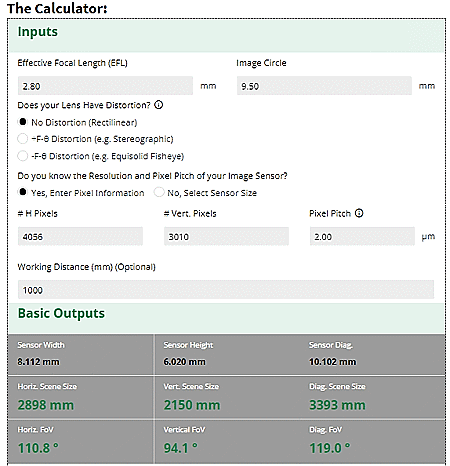
Commonlands.com provides a Camera Field of View Calculator that calculates the camera’s field of view based on an image sensor and a lens. The field of view of a camera depends on the focal length of the lens, the image sensor size, the lens distortion, and the lens image circle. This calculator can perform basic calculation and advanced calculations.
For basic calculations, you have to provide an Effective focal length and Image Circle along with camera sensor dimensions and working distance. With that, it determines the field of view and screen size. Below that, it also gives you the angular resolution for the calculation. Then the calculator has a crop factor section where you can add the sensor resolution after the crop and perform the field of view with crop factor.
How to calculate the camera field of view?
- Open this calculator and enter the Effective focal length along with Image Circle.
- Then set the Lens distortion along with sensor dimensions and working distance.
- This gets you the camera’s field of view and angular resolution.
Highlights:
- This calculator calculates the camera’s field of view based on an image sensor and a lens.
- It factors in lens distortion and image circle into the calculation.
- Along with the field of view, it also determines the angular resolution and field of view with a crop factor.
- It gives you an option to share the results via email.
UltimateSecurity.com
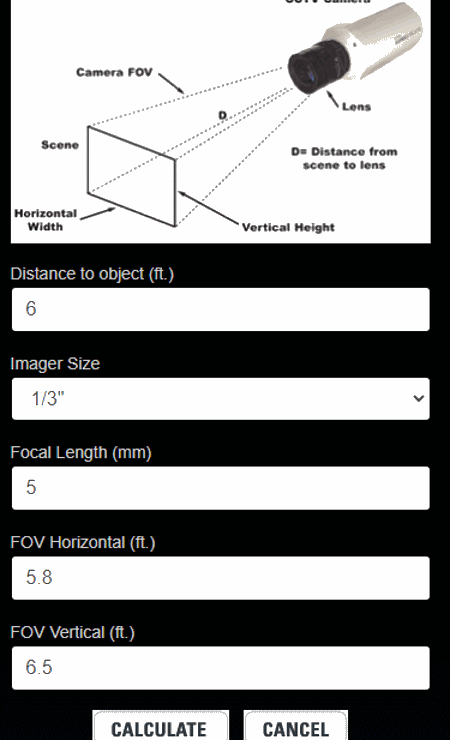
UltimateSecurity.com provides a field of view calculator tool that helps you determine the horizontal and vertical field of view of the camera. This calculator estimates the field of view based on the distance, image size, and focal length. Image size is the sensor size of the camera. For a standard CS mount case camera, you can enter 1/3. You can pick the image of your configurations and use the calculator to calculate the field of view.
How to calculate the camera field of view?
- Enter the distance to the object in the top field of the calculator.
- Then select the image size of the camera and enter the focal length of the lens.
- After that, click the Calculate button to see the resulting horizontal (width) and vertical (height) FOV.
Highlights:
- This is a simple calculator that determines horizontal and vertical FOV.
- It asks for sensor size to calculate the field of view.
1stVision.com
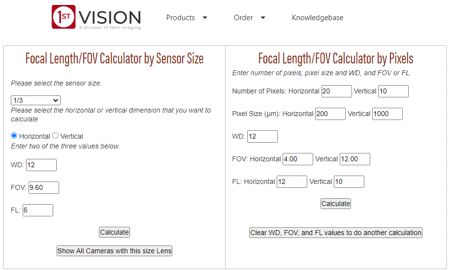
1stVision.com offers a free online field-of-view lens calculator. This calculator can calculate focal length or field of view. If you know the focal length (FL) and working (WD), you can use that to calculate the field of view (FOV). Alternatively, if you know the FOV, you can use that to calculate the focal length.
There are two calculators side by side, one calculates by sensor size and the other calculates by pixels. Depending on what information you have about the camera sensor, you can use the respective calculator and determine the field of view.
How to calculate the camera field of view?
- Select the calculator you want to use.
- Enter the working distance (WD) and focal length (FL) into the calculator.
- Then set the camera size or pixel count based on the calculator you selected.
- Run the calculator to get the field of view.
Highlights:
- This calculator can calculate the field of view by sensor size or pixels.
- It calculates horizontal and/or vertical fields of view.
Pelco.com
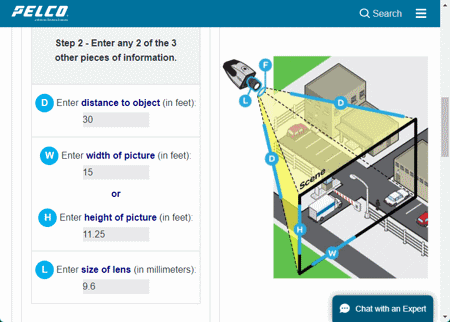
Pelco.com has a bi-functional calculator that calculates lens millimeter selection according to area size. This is a simple calculator that you can use to determine the field of view, distance, or lens size. The calculator has two steps. The first step asks you to pick the lens format that you are using. This step is common for any calculation. The second step has three inputs and you have to provide two inputs to calculate the third. That means you can enter distance and lens size to get the horizontal and vertical FOV. You can enter FOV and distance to calculate the lens size. Or, you can enter FOV and lens size to calculate the distance.
How to calculate the camera field of view?
- Open this calculator using the direct link provided below.
- Select the lens format that you are using in Step 1.
- In step 2, enter the distance and size of the lens.
- Then click the Calculate button to get the width and height of the picture which is the FOV.
Highlights:
- This calculator calculates the field of view from distance and lens size.
- It can also calculate lens size from the field of view (horizontal and vertical).
ChannelSystems.ca
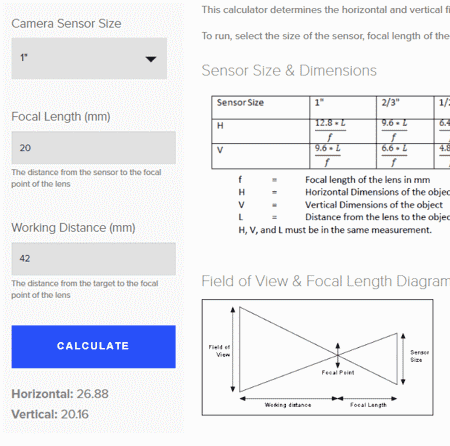
ChannelSystems.ca has a simple field of view calculator that you can use to find the vertical and horizontal FOV of a camera sensor. This calculator works for 1″, 2/3″, 1/2″, 1/3″, and 1/4″ sensor sizes. You can select any of these sensor sizes and then add your input to calculate the field of view. Apart from that, the calculator shows a table where you can view the Sensor Size & Dimensions. along with a Field of View & Focal Length Diagram.
How to calculate the camera field of view?
- Select the Camera Sensor Size from the dropdown.
- Enter the Focal length and Working Distance into the calculator.
- Click the Calculate button to get the horizontal and vertical field of view.
Highlights:
- This calculator calculates vertical and horizontal field of view.
- It works 5 types of sensor sizes covering 1″, 2/3″, 1/2″, 1/3″, and 1/4″.
Fluke.com

Fluke.com is a company that sells infrared cameras for a wide range of applications. Their website features a field of view calculator that works for their own cameras and lenses. The calculator lists Fluke cameras and lenses. You can simply pick the camera and lens setup of your choice. Then you can select whether you want to get FOV for a distance or a spot. Depending on that, you can add the distance in the unit of your choice. The calculator then loads a visualization on the screen that shows the setup. The visualization also shows the vertical and horizontal FOV.
How to calculate the camera field of view?
- Go to this calculator in your browser using the direct link given below.
- Click on the Camera dropdown and select a camera of your choice. Similarly select a lens for the camera.
- After that, choose between Distance and Spot in the next dropdown.
- Select the distance unit and enter the value to get the FOV.
Highlights:
- This calculator calculates the field of view for a distance or spot.
- It visually represents the setup and shows the vertical and horizontal FOV.
- The calculator works for a selective number of fluke cameras and lenses.
Workswell-Thermal-Camera.com
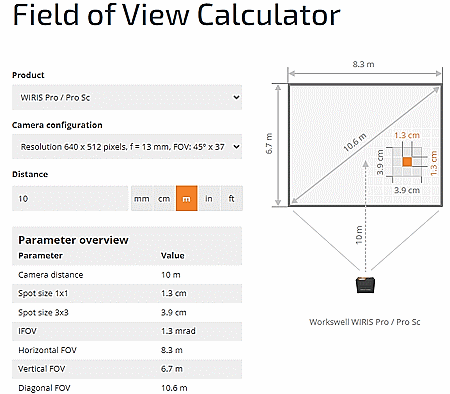
Workswell-Thermal-Camera.com is another brand that sells thermal cameras. Their website has a Field of View Calculator that you can use for their products. If you use Workswell products and know your camera configurations then it is simple to use this tool. You can pick the product and configuration from the drop lists. Then all you have to do is enter the distance. With that, the calculator shows you a list of parameters it calculated for you. It covers spot size 1×1, spot size 3×3, IFOV, Horizontal FOV, Vertical FOV, and Diagonal FOV. It also shows a visualization with the camera setup and results mapped on it.
How to calculate the camera field of view?
- Follow the link given below leading to this calculator.
- Select the Workswell product and pick the camera configurations from the list.
- Then enter the distance in the desired unit to get the FOV.
Highlights:
- This calculator calculates horizontal, vertical, and diagonal FOV.
- It also calculates FOV for 1×1 and 3×3 spot sizes.
- This calculator is limited to Workswell camera products only.
Frequently Asked Questions
Camera field of view (FOV) refers to the angle of the scene that a camera can capture and record as an image or video. It is measured in degrees and determined by the camera's lens focal length and sensor size.
Field of view (FOV) can be calculated by considering the focal length of the camera lens and the size of the camera sensor. A shorter focal length or larger sensor results in a wider FOV, while a longer focal length or smaller sensor provides a narrower FOV.
The unit of FOV (Field of View) is typically expressed in degrees (°). It represents the angular coverage of the scene that a camera or optical device can capture. For example, a FOV of 90° means that the camera can capture an area that spans 90 degrees from one side of the frame to the other.
The formula to calculate FOV (Field of View) based on focal length and sensor size is: FOV (in degrees) = 2 * arctan(sensor size / (2 * focal length)), where the sensor size and focal length are in the same unit.
The field of view of an 18mm lens depends on the camera's sensor size. However, assuming a standard 35mm full-frame sensor, the FOV is approximately 66.5 degrees horizontally.
The standard field of view in cameras can vary depending on the camera type and its intended use. However, for many standard or kit lenses on APS-C sensor cameras, the FOV ranges from approximately 28mm to 35mm (full-frame equivalent) with a horizontal FOV of about 50 to 65 degrees.
The field of view of a camera resolution refers to the portion of the scene that the camera's imaging sensor can capture in terms of width, height, or diagonal dimension. It is not directly determined by the camera resolution but is influenced by factors such as the lens focal length and sensor size.
Camera field depth, also known as depth of field (DOF), is the range of distances in a scene that appears acceptably sharp in the final image. It is controlled by factors such as the lens aperture, focal length, and camera sensor size, with wider apertures producing shallower DOF and smaller apertures resulting in deeper DOF.
About Us
We are the team behind some of the most popular tech blogs, like: I LoveFree Software and Windows 8 Freeware.
More About UsArchives
- May 2024
- April 2024
- March 2024
- February 2024
- January 2024
- December 2023
- November 2023
- October 2023
- September 2023
- August 2023
- July 2023
- June 2023
- May 2023
- April 2023
- March 2023
- February 2023
- January 2023
- December 2022
- November 2022
- October 2022
- September 2022
- August 2022
- July 2022
- June 2022
- May 2022
- April 2022
- March 2022
- February 2022
- January 2022
- December 2021
- November 2021
- October 2021
- September 2021
- August 2021
- July 2021
- June 2021
- May 2021
- April 2021
- March 2021
- February 2021
- January 2021
- December 2020
- November 2020
- October 2020
- September 2020
- August 2020
- July 2020
- June 2020
- May 2020
- April 2020
- March 2020
- February 2020
- January 2020
- December 2019
- November 2019
- October 2019
- September 2019
- August 2019
- July 2019
- June 2019
- May 2019
- April 2019
- March 2019
- February 2019
- January 2019
- December 2018
- November 2018
- October 2018
- September 2018
- August 2018
- July 2018
- June 2018
- May 2018
- April 2018
- March 2018
- February 2018
- January 2018
- December 2017
- November 2017
- October 2017
- September 2017
- August 2017
- July 2017
- June 2017
- May 2017
- April 2017
- March 2017
- February 2017
- January 2017
- December 2016
- November 2016
- October 2016
- September 2016
- August 2016
- July 2016
- June 2016
- May 2016
- April 2016
- March 2016
- February 2016
- January 2016
- December 2015
- November 2015
- October 2015
- September 2015
- August 2015
- July 2015
- June 2015
- May 2015
- April 2015
- March 2015
- February 2015
- January 2015
- December 2014
- November 2014
- October 2014
- September 2014
- August 2014
- July 2014
- June 2014
- May 2014
- April 2014
- March 2014








